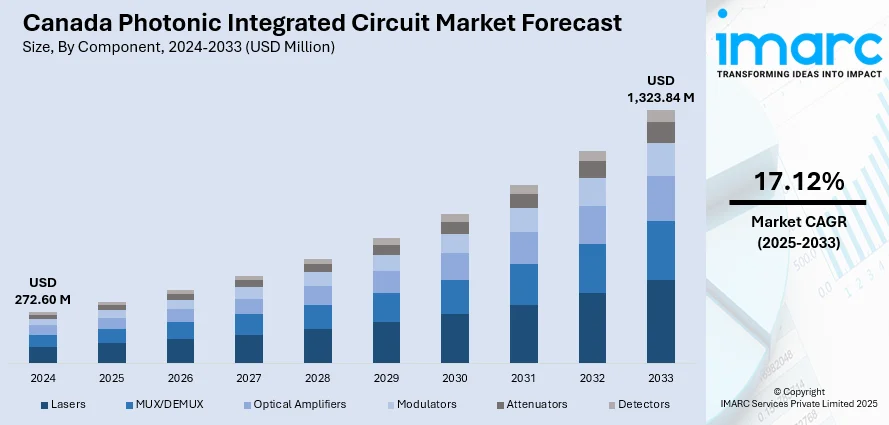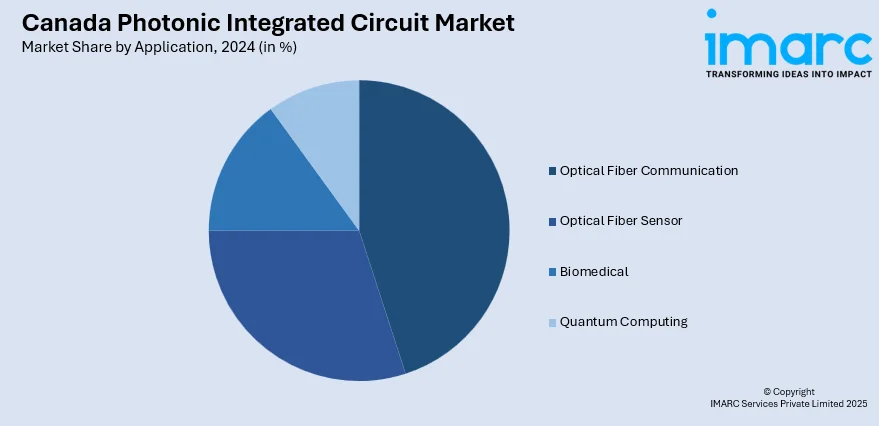
Canada Photonic Integrated Circuit Market Size, Share, Trends and Forecast by Component, Raw Material, Integration, Application, and Region, 2025-2033
Canada Photonic Integrated Circuit Market Overview:
The Canada photonic integrated circuit market size reached USD 272.60 Million in 2024. Looking forward, IMARC Group expects the market to reach USD 1,323.84 Million by 2033, exhibiting a growth rate (CAGR) of 17.12% during 2025-2033. Technological innovation in silicon photonics, increasing demand from telecom and data‑center sectors, strong R&D funding, and emerging startup‑industry collaborations are key forces shaping this market. Enhanced integration of laser, modulator, and waveguide components supports efficiency improvements, influencing Canada photonic integrated circuit market share.
|
Report Attribute
|
Key Statistics
|
|---|---|
|
Base Year
|
2024
|
|
Forecast Years
|
2025-2033
|
|
Historical Years
|
2019-2024
|
| Market Size in 2024 | USD 272.60 Million |
| Market Forecast in 2033 | USD 1,323.84 Million |
| Market Growth Rate 2025-2033 | 17.12% |
Canada Photonic Integrated Circuit Market Trends:
Shift Toward Heterogeneous Integration
Canada’s photonic integrated circuit landscape increasingly emphasizes heterogeneous integration, merging silicon photonics with III–V materials to optimize on‑chip lasers and modulators. This approach dramatically enhances optical performance, reduces propagation losses, and increases energy efficiency, advancing Canada photonic integrated circuit market growth. Research institutions and startups collaborate with established manufacturers to develop hybrid substrates and integrated photonic platforms. Pilot fabs, especially around innovation hubs in Ontario and Quebec, are boosting manufacturing readiness and supply chain robustness. At the same time, demand from telecom operators and hyperscale data centers for compact, low‑latency interconnect solutions accelerates adoption. This trend underscores Canada’s strategic momentum in photonic integration and the technological sophistication of its domestic ecosystem. For instance, the Canadian Photonics Fabrication Centre (CPFC) joined AIM Photonics as a full member, enhancing the North American integrated photonics supply chain. CPFC, a III-V compound semiconductor foundry based in Ottawa, offers high-volume manufacturing of lasers, amplifiers, and photonic ICs. This partnership complements AIM Photonics' packaging expertise and supports advanced photonic technologies, including quantum and optical computing. Together, they aim to complete the photonics manufacturing value chain and accelerate PIC deployment.

To get more information on this market, Request Sample
Government and Ecosystem Support
Government initiatives are pivotal in bolstering Canada’s photonic integrated circuit ecosystem. National and provincial R&D grants fund collaborative programs between universities, startups, and established semiconductor firms, driving Canada photonic integrated circuit market growth. Foundations such as the National Research Council’s NCRI (National Capital Region Innovation) and provincial innovation agencies support cleanroom facilities and pilot production lines. These resources lower entry barriers for new entrants and enhance competitiveness. Growing presence of industry clusters around Toronto, Ottawa, and Montréal fosters knowledge exchange and supply‑chain integration. Furthermore, strategic partnerships within consortia facilitate access to global markets. Sustained public‑private ecosystem investment ensures a robust and resilient Canadian PIC landscape positioned for long‑term technological and commercial success. For instance, in January 2025, Quantum Computing Inc. (QCi) received its fifth purchase order for its thin-film lithium niobate (TFLN) photonic chip foundry, supporting quantum photonics research by a Canadian group. The order includes custom test structures and access to future MPW runs. QCi also launched its photonic integrated circuit (PIC) Process Design Kit (PDK) on the GDSFactory platform, enabling users to simulate designs before manufacturing.
Canada Photonic Integrated Circuit Market Segmentation:
IMARC Group provides an analysis of the key trends in each segment of the market, along with forecasts at the country and regional levels for 2025-2033. Our report has categorized the market based on component, raw material, integration, and application.
Component Insights:
- Lasers
- MUX/DEMUX
- Optical Amplifiers
- Modulators
- Attenuators
- Detectors
The report has provided a detailed breakup and analysis of the market based on the component. This includes lasers, MUX/DEMUX, optical amplifiers, modulators, attenuators, and detectors.
Raw Material Insights:
- Indium Phosphide (InP)
- Gallium Arsenide (GaAs)
- Lithium Niobate (LiNbO3)
- Silicon
- Silica-on-Silicon
A detailed breakup and analysis of the market based on the raw material have also been provided in the report. This includes indium phosphide (InP), gallium arsenide (GaAs), lithium niobate (LiNbO3), silicon, and silica-on-silicon.
Integration Insights:
- Monolithic Integration
- Hybrid Integration
- Module Integration
The report has provided a detailed breakup and analysis of the market based on the integration. This includes monolithic integration, hybrid integration, and module integration.
Application Insights:

- Optical Fiber Communication
- Optical Fiber Sensor
- Biomedical
- Quantum Computing
A detailed breakup and analysis of the market based on the application have also been provided in the report. This includes optical fiber communication, optical fiber sensor, biomedical, and quantum computing.
Regional Insights:
- Ontario
- Quebec
- Alberta
- British Columbia
- Others
The report has also provided a comprehensive analysis of all the major regional markets, which include Ontario, Quebec, Alberta, British Columbia, and others.
Competitive Landscape:
The market research report has also provided a comprehensive analysis of the competitive landscape. Competitive analysis such as market structure, key player positioning, top winning strategies, competitive dashboard, and company evaluation quadrant has been covered in the report. Also, detailed profiles of all major companies have been provided.
Canada Photonic Integrated Circuit Market News:
- In August 2025, Xanadu and DISCO Corporation partnered to develop advanced wafer processing techniques for photonic quantum computing. The collaboration focuses on wafer dicing, grinding, and polishing to reduce optical losses and support scalable photonic chip packaging. DISCO’s precision technologies enhance Xanadu’s ability to produce ultra-low loss photonic integrated circuits critical for utility-scale quantum computing. This partnership also supports heterogeneous integration processes. Both companies aim to push industry standards in manufacturing quality, scalability, and efficiency for cutting-edge quantum and photonic applications.
- In June 2024, Intel unveiled the first fully integrated optical compute interconnect (OCI) chiplet, co-packaged with a CPU and demonstrated live at OFC 2024. This chiplet supports 4 Tbps bidirectional data transfer over fiber optics, enabling high-bandwidth, energy-efficient optical I/O for AI and HPC systems. With only 5 pJ/bit power consumption, it addresses growing AI infrastructure demands. Built on Intel’s silicon photonics platform, it marks a major step toward scalable, next-gen compute systems with optical interconnects replacing traditional electrical I/O limitations.
Canada Photonic Integrated Circuit Market Report Coverage:
| Report Features | Details |
|---|---|
| Base Year of the Analysis | 2024 |
| Historical Period | 2019-2024 |
| Forecast Period | 2025-2033 |
| Units | Million USD |
| Scope of the Report |
Exploration of Historical Trends and Market Outlook, Industry Catalysts and Challenges, Segment-Wise Historical and Future Market Assessment:
|
| Components Covered | Lasers, MUX/DEMUX, Optical Amplifiers, Modulators, Attenuators, Detectors |
| Raw Materials Covered | Indium Phosphide (InP), Gallium Arsenide (GaAs), Lithium Niobate (LiNbO3), Silicon, Silica-on-Silicon |
| Integrations Covered | Monolithic Integration, Hybrid Integration, Module Integration |
| Applications Covered | Optical Fiber Communication, Optical Fiber Sensor, Biomedical, Quantum Computing |
| Regions Covered | Ontario, Quebec, Alberta, British Columbia, Others |
| Customization Scope | 10% Free Customization |
| Post-Sale Analyst Support | 10-12 Weeks |
| Delivery Format | PDF and Excel through Email (We can also provide the editable version of the report in PPT/Word format on special request) |
Key Questions Answered in This Report:
- How has the Canada photonic integrated circuit market performed so far and how will it perform in the coming years?
- What is the breakup of the Canada photonic integrated circuit market on the basis of component?
- What is the breakup of the Canada photonic integrated circuit market on the basis of raw material?
- What is the breakup of the Canada photonic integrated circuit market on the basis of integration?
- What is the breakup of the Canada photonic integrated circuit market on the basis of application?
- What is the breakup of the Canada photonic integrated circuit market on the basis of region?
- What are the various stages in the value chain of the Canada photonic integrated circuit market?
- What are the key driving factors and challenges in the Canada photonic integrated circuit market?
- What is the structure of the Canada photonic integrated circuit market and who are the key players?
- What is the degree of competition in the Canada photonic integrated circuit market?
Key Benefits for Stakeholders:
- IMARC’s industry report offers a comprehensive quantitative analysis of various market segments, historical and current market trends, market forecasts, and dynamics of the Canada photonic integrated circuit market from 2019-2033.
- The research report provides the latest information on the market drivers, challenges, and opportunities in the Canada photonic integrated circuit market.
- Porter's five forces analysis assist stakeholders in assessing the impact of new entrants, competitive rivalry, supplier power, buyer power, and the threat of substitution. It helps stakeholders to analyze the level of competition within the Canada photonic integrated circuit industry and its attractiveness.
- Competitive landscape allows stakeholders to understand their competitive environment and provides an insight into the current positions of key players in the market.
Need more help?
- Speak to our experienced analysts for insights on the current market scenarios.
- Include additional segments and countries to customize the report as per your requirement.
- Gain an unparalleled competitive advantage in your domain by understanding how to utilize the report and positively impacting your operations and revenue.
- For further assistance, please connect with our analysts.
 Request Customization
Request Customization
 Speak to an Analyst
Speak to an Analyst
 Request Brochure
Request Brochure
 Inquire Before Buying
Inquire Before Buying




.webp)




.webp)












